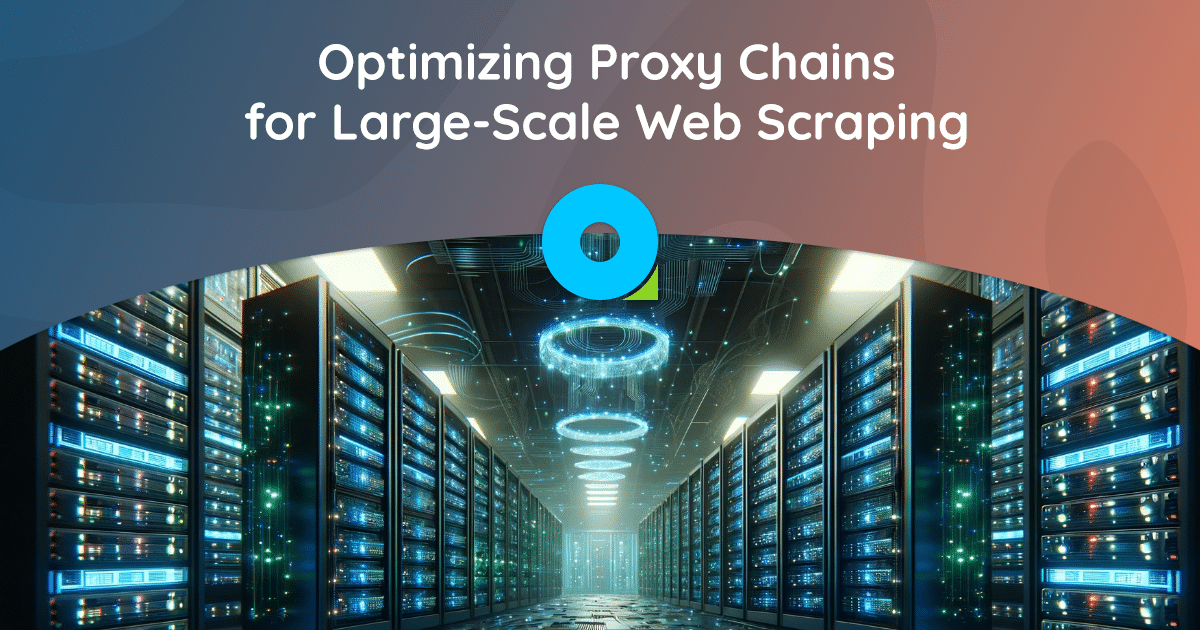
Advanced methods for optimizing proxy chains in bulk web scraping
Extracting valuable data without the risk of being blocked or discovered may seem like a daunting task. But what if there were simple ways to securely collect data? That’s right, you can handle large-scale web scraping if you use a chain of proxies. You will learn more about proxy chains and how to use them in this article. Arm yourself with knowledge and learn how to effectively manage ANY web scraping project.
Understanding Proxy Chains
If you’re just getting started with bulk web scraping, you’ll need to first understand the concept of proxy chains. This is a carefully planned sequence that is the basis of covert data collection.
In short, these chains are a series of interconnected servers. When you send a request to a site, it goes through this chain before reaching its destination. Each node in the chain forwards your request to the next one, effectively masking your original IP address and location. So, the main advantages of this approach are:
- anonymity,
- safety,
- flexibility.
Understanding the intricacies of these chains is the first step to mastering large-scale web scraping. Later you will learn why they are necessary in scraping and how to set them up.
Why Are Proxy Chains Needed in Scraping?

The use of proxy chains can significantly improve the efficiency of data collection. Let’s look at the main benefits they provide.
Increased Level of Anonymity
Proxy chains create multiple layers of IP addresses between you and the target site. This makes it virtually impossible for the site to trace the source of the request and get to your real IP address.
Each intermediary in the chain contributes to the creation of a more complex digital trail, causing your web scraping activities to get lost in the vast flood of Internet traffic.
Want to learn more about anonymous surfing? Here you can familiarize yourself with 4 ways to stay anonymous online.
Reliable Protection Against Ip Address Blocking
Constant IP rotation allows you to minimize the risk of detection and blocking of a separate proxy server. This constantly updated front-end interface is necessary for continuous access to the target site.
In addition, advanced chains can distribute requests based on the status and performance of each intermediary, which further reduces the likelihood of activation of anti-scraping systems installed on the site.
Geo Targeting
Proxy chains can include servers from different geographic locations. This allows you to access specific data that may not be available due to geographic restrictions.
With servers from specific regions, you can effectively customize your web scraping operations. This will make your requests appear to be coming from those regions, giving you access to a wealth of local information.
Setting up Proxy Chains: 3 Basic Steps
Step #1: Selecting Proxy Types
To build a chain of servers, it is best to use a combination of residential, data center and mobile IPs, which will create a diverse and stable pool of IP addresses. If you plan to use one specific type of server, make sure it suits your purposes:
- Residential Proxies: Due to their connection to real IP addresses, these servers are ideal for providing a high level of anonymity. They are less susceptible to markings, but are usually slower.
- Data center Proxies: These intermediaries are known for their high speed and efficiency. They are ideal for tasks that require fast response, but are more prone to detection and blocking.
- Mobile Proxies: They are connected to mobile devices, making them highly effective for tasks that require high levels of trust and low blocking rates.
Step #2: Proxy Rotation Logic
Smart rotation is the key to avoiding blocking. Here are three main factors to consider when setting up server rotation:
- Request frequency: Adjust the frequency of rotation depending on the volume of your requests. Larger scale scraping may require more frequent rotation.
- Site sensitivity: Some sites install complex anti-scraping systems. When working with such sites, use a diverse pool and rotate servers as often as possible.
- Proxy performance: Monitor and replace servers that show signs of slowing down or blocking.
Step #3: Geo-diversification
For geo-specific data scraping, the geographic diversity of your pool is critical. Your proxies should cover multiple regions – this will allow you to access localized content and avoid unwanted geo-blocking.
Methods for Setting up Proxy Chains

Load Distribution
The goal of load balancing is to distribute web scraping requests evenly across your pool. This way, each server will carry a balanced load, which will protect the servers from overload and reduce the risk of detection. Let’s take a closer look at how you can achieve this.
- Dynamic request distribution
Implement algorithms that dynamically allocate requests based on current performance. This will reduce the likelihood that a busy server with reduced speed will become a vulnerable link in the proxy chain.
- Regularly checking the proxy status
Integrate a system to continuously monitor proxy status. If a server regularly exhibits high latency or errors, it should be temporarily removed from use or replaced.
- Weighted load distribution tactics
Assign more requests to the most reliable and fastest servers, but do not neglect the slow ones. This weighted distribution will help keep traffic looking natural (and avoid detection in the long run).
Session Management
When scraping sites that track user interactions or require registration, special care should be taken to maintain integrity. This is where regular sessions come to the rescue. These are needed to maintain the same IP address over a series of requests from your scraper. Here are some great tips for managing sessions.
- Intelligent configuration of persistent sessions
Design a system where a proxy server is assigned a specific session. During this session he will have to process all requests. This will help maintain consistency and reduce the risk of triggering security alarms on the target site.
- Regulating session time
There is a delicate balance to be struck here. If the session is too short, you may not have time to complete the task. Too long and you risk finding yourself out. Control the length of each session based on site sensitivity and typical user behavior.
- Periodic rotation of sessions
To hide data collection activities, regularly change the servers dedicated to specific sessions. This will simulate the behavior of a regular user who uses different devices or networks to browse.
Adaptive Timing
One of the main features of automated scraping is query timing. Sites can easily detect non-human behavior patterns, such as uniform intervals between requests. In this case, the problem can be solved using adaptive timing. Here are some tips for setting it up.
- Injecting Random Delays
Introduce random delays between requests. It is important that they do not follow any predictable pattern, but vary in length. The main goal is to simulate the behavior of an ordinary person while browsing a website.
- Simulation of behavioral patterns
Analyze typical user behavior on the target site and, based on this, adjust the intervals between requests. For example, after a series of rapid queries, introduce a longer pause, just as a real user would do when reading content.
- Reasonable speed limit
Set thresholds for the number of requests sent in a certain time period. This rate limit should be flexible, adapting to different times of day or different target sites. It is important to maintain a non-aggressive behavior pattern similar to the series of requests of an ordinary user.
Optimizing Proxy Chains
Performance Monitoring
The key to optimizing your proxy chain is to closely monitor performance. It’s not just about tracking response times or success metrics, as many people think. It is important to understand the complex dynamics of how different proxies interact with target sites.
For example, analyzing variations in response time over different periods allows us to identify patterns in the behavior of sites. This approach helps to set up IP rotation for a specific site and identify in advance servers that may be subject to site blocking in the near future.
How to check proxy performance? Check out the main ways to test proxy servers.
Proactive Proxy Management
Effective proxy management means anticipating performance issues and adapting the server configuration accordingly. For example, by analyzing historical data, you can identify addresses that are most likely to be blocked during peak hours on certain sites and proactively exclude them from your chain. This will keep your IP pool fresh and reduce the risk of encountering blocks or CAPTCHAs.
Additionally, setting performance metrics specific to your scraping goals allows you to more accurately evaluate the intermediary’s effectiveness. For example, if scraping speed is important to you, it is better to focus on time to first byte – this metric may be more meaningful than just looking at overall success rates.
Balance Between Blacklist Management and Scalability
It is extremely difficult to maintain the effectiveness of blacklist management and maintain the same rate of scalability. However, advanced technologies such as machine learning algorithms can predict, based on proxy usage patterns, which ones are at risk of being blacklisted and which ones are not.
From a scalability perspective, it’s critical to focus on infrastructure that can dynamically adapt to your needs. Implementing a cloud-based proxy management system can provide the flexibility to quickly scale your project depending on your scraping requirements.
Bypassing CAPTCHA and Blocking
Integrating tools to bypass CAPTCHAs involves, first of all, finding a solution that matches the complexity and frequency of CAPTCHAs encountered. For example, basic OCR (optical character recognition) solutions may be suitable for simple CAPTCHA images. More complex CAPTCHAs, such as reCAPTCHA, require advanced AI-based solutions. The choice of CAPTCHA solution significantly affects the effectiveness of scraping.
When it comes to backup plan strategies, it is important to implement them regularly. Simply changing proxies when a blockage is detected may be effective, but not in the long term. A more subtle approach involves analyzing the type of blocking or CAPTCHA. If the blocking is due to request rate limiting, it is much more efficient to slow down the rate of requests or change the user agent than to simply replace the server.
Security and Compliance in Scraping
For many, security and compliance in web scraping are just a formality, but their importance cannot be underestimated. If you want to encrypt your connections, it is extremely important to use an HTTPS proxy. It is also necessary to understand the security protocols of the intermediaries themselves. Choose services that offer strong encryption and security features to protect your data from potential threats.
Best Practices for Setting up Proxy Chains
If you want to succeed in web scraping, continually work on improving your strategies and making them more adaptable. Here are some practices that have proven their worth over the years.
- Regular Updates
Keeping your list of proxies and scraping scripts up to date is critical, and it’s not just about routine maintenance. For example, if you’re keeping your proxy list up to date, don’t limit yourself to replacing non-functional servers.
Analyze trends and proactively update your server pool to suit the current website dynamics. The same applies to updating scraping scripts – this includes not only correcting errors, but also adapting to changes in site structures and anti-scraping technologies.
- Testing and Validation
Regular testing of your proxy chain settings is critical and should go beyond basic functionality checks. Monitor performance closely under different conditions.
For example, testing your proxy chain under high load conditions can reveal potential vulnerabilities or weaknesses in your configuration. Implementing automated test scripts that simulate real-life scraping tasks can provide deep insight into the reliability and efficiency of your chain.
- Full documentation
It is important to keep all documentation of proxy configurations, their changes and updates, as this will be needed in the future to scale operations. Such documentation should include technical details and detailed rationales behind each configuration choice.
Documenting the performance impact of different broker configurations will help guide the scaling optimization process. Likewise, keeping a change log can be incredibly useful for understanding the evolution of scraping settings.
Finally
Optimizing proxy chains for bulk scraping is a complex task that requires analyzing configurations over time. You are now familiar with the most productive methods that can significantly improve the efficiency of your scraping, maintain anonymity, and reduce the risk of detection and blocking. Remember, the key to successful scraping is using technology intelligently and ethically!





